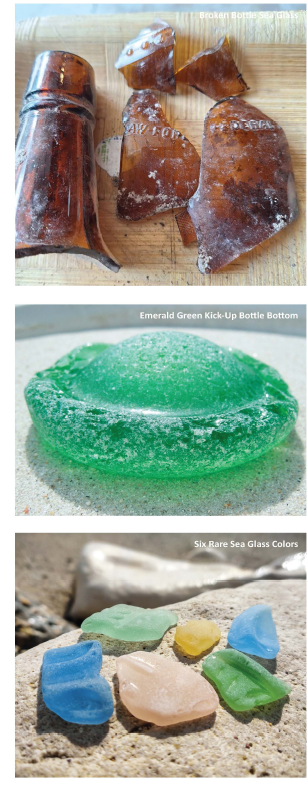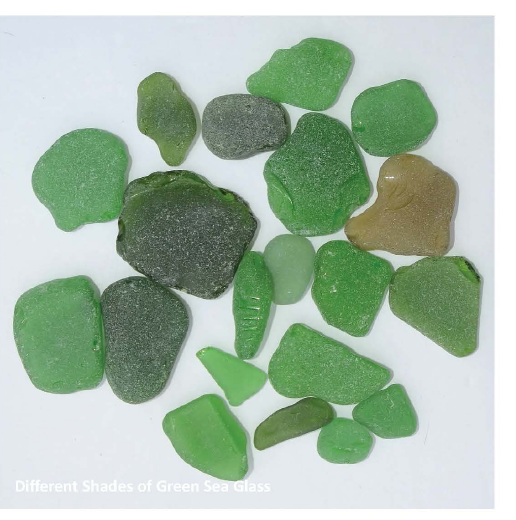Sea glass is considered by many of us to be as precious as any natural gem and can sometimes seem harder to find. The difference is that sea glass is made by man and refined by nature, while diamonds and other gemstones are created by nature and refined by man.
Galveston Island has a reputation among beachcombers for being an inadequate place to find sea glass. That is partly true.
As plastic containers continue to replace traditional glass bottles, beachcombers are finding fewer glass treasures than in decades past. Still, there's likely enough sea glass scattered along the shores to keep collectors hunting for generations.
On Galveston’s beaches, however, sea glass tends to be less polished than what’s found on the East Coast. That’s because our island’s fine, powdery sand takes longer to smooth and frost the glass compared to the coarse, gritty sands of rockier coastlines. As a result, we often come across pieces that aren't fully “cooked” - shards that are not yet ready for picking.
As a test, I once put a few pieces of freshly broken glass in a rock tumbler with a handful of Galveston beach sand to find how long it took to become sea glass. After six months of tumbling 12 hours a day, the glass barely had any rounding or frosting.
It’s hard to imagine just how many years it takes for the Gulf to craft a fully rounded piece of sea glass. The key lies in finding pockets of shell hash and coarse sand - natural abrasives that help etch and smooth the glass as it tumbles in the surf.
Galveston’s history of powerful hurricanes is one of the reasons so much glass and pottery ends up in the Gulf. Add to that dishware tossed overboard by ships or bottles left behind on the beach, only to be swept out by the next high tide, and you’ve got the makings of countless shoreline treasures.
 However it finds its way into the Gulf, the glass gradually breaks down over time, eventually washing ashore as frosted gems in a variety of shapes, sizes and colors. These stunning pieces of sea glass are often then transformed by artisans into exquisite jewelry that rivals the brilliance of emeralds and sapphires.
However it finds its way into the Gulf, the glass gradually breaks down over time, eventually washing ashore as frosted gems in a variety of shapes, sizes and colors. These stunning pieces of sea glass are often then transformed by artisans into exquisite jewelry that rivals the brilliance of emeralds and sapphires.
Discarded beer, liquor, and soda bottles - typically green, clear, or brown - make up about 90 percent of the sea glass found locally. One of the most recognizable colors is the distinctive light green of old Coca-Cola bottles.
The degree of opacity in a piece of sea glass depends on how long it has been tumbling in the surf. Greens and browns generally retain their color, while clear glass transforms into a smooth, frosted white.
The remaining 10 percent of sea glass is far rarer. Blue pieces are especially coveted and once made up only a tiny portion of most collections but they're becoming slightly more common as some beer and wine brands now favor blue glass.
Some of the oldest shoreline discoveries include fragments of pottery, china, porcelain, milk glass, and Depression glass - everyday household items that date back to the 1700s through the early 1900s.
Among the most recognizable is Blue Willow, the world’s most popular china pattern, still produced today and commonly found on beaches in broken but familiar form. Colorful shards of Fiestaware, a favorite from the 1950s to the 1970s, also stand out thanks to their distinctive hues.
Beyond its natural beauty, sea glass holds a certain mystery - each piece a fragment of someone else’s story. It sparks curiosity: Who once held this shard, and how long ago did it journey to the sea?
Like pieces of a jigsaw puzzle, broken bottles offer clues to the past. Embossed markings, backstamps, lettering, and - if fortune favors - a date, can help identify their origin. Even the thickness of the glass can hint at its age.
Features like “kick-ups” - the cupped bottom portion of old bottles - and distinct bottleneck shapes provide further insight, allowing collectors to trace a shard back to its era with surprising accuracy.
In 2024, I discovered a fully intact, beautifully frosted Coke bottle on the beach at Galveston’s west end. Embossed on the bottom were the words “Galveston Tex,” a detail that led me to learn that the local Coca-Cola Bottling Company operated from 1939 to 1981. That means this bottle is at least 43 years old - and possibly as old as 86.
Wondering where the best places on Galveston Island are to hunt for sea glass - and whether there are any hidden gems? The answer is yes.
One of the most reliable spots is along the edges of the rock jetties that line the Seawall, where shell hash naturally collects. These areas are easiest to explore at low tide, when more of the shoreline is exposed.
 Keep an eye out for white tile fragments, too - sometimes flipping them over reveals printed designs hidden on the underside.
Keep an eye out for white tile fragments, too - sometimes flipping them over reveals printed designs hidden on the underside.
Another great spot to search is the stretch of beach behind Woody’s Bar on FM 3005 - the former site of the Down Beat Bar, which burned down in the 1950s. During very low tides and calm seas, you can still spot brick fragments and the remnants of old pilings.
Keep an eye out for bonfire glass, too - melted and reshaped by fire before being softened by the surf, these rare pieces have transformed into some of the most unique sea glass treasures around.
There’s nothing more rewarding than discovering a rare piece of sea glass. The few small shards and antique bottles I’ve found so far are enough to keep me combing the shoreline, always hopeful for what the tide might uncover next.
Pirate glass - also known as black glass - is considered one of the rarest finds. Despite the name, it didn’t come from a pirate ship; it gets its name from its incredibly dark hue.
In 23 years of beachcombing, I’ve only found one piece. Typically, it's a deep green or purple so dark it appears black - until you hold it up to the sunlight and its true color is revealed.